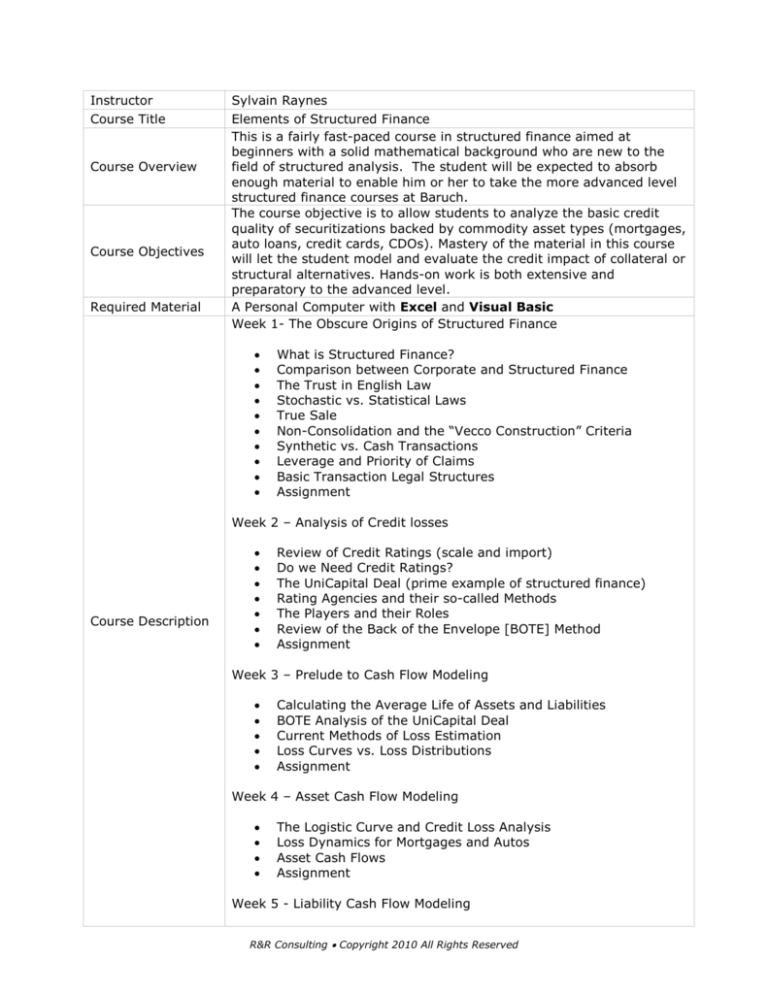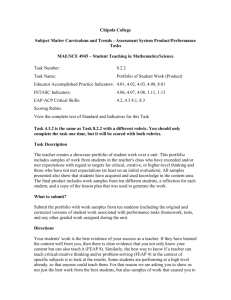
Instructor
Course Title
Course Overview
Course Objectives
Required Material
Sylvain Raynes
Elements of Structured Finance
This is a fairly fast-paced course in structured finance aimed at
beginners with a solid mathematical background who are new to the
field of structured analysis. The student will be expected to absorb
enough material to enable him or her to take the more advanced level
structured finance courses at Baruch.
The course objective is to allow students to analyze the basic credit
quality of securitizations backed by commodity asset types (mortgages,
auto loans, credit cards, CDOs). Mastery of the material in this course
will let the student model and evaluate the credit impact of collateral or
structural alternatives. Hands-on work is both extensive and
preparatory to the advanced level.
A Personal Computer with Excel and Visual Basic
Week 1- The Obscure Origins of Structured Finance
What is Structured Finance?
Comparison between Corporate and Structured Finance
The Trust in English Law
Stochastic vs. Statistical Laws
True Sale
Non-Consolidation and the “Vecco Construction” Criteria
Synthetic vs. Cash Transactions
Leverage and Priority of Claims
Basic Transaction Legal Structures
Assignment
Week 2 – Analysis of Credit losses
Course Description
Review of Credit Ratings (scale and import)
Do we Need Credit Ratings?
The UniCapital Deal (prime example of structured finance)
Rating Agencies and their so-called Methods
The Players and their Roles
Review of the Back of the Envelope [BOTE] Method
Assignment
Week 3 – Prelude to Cash Flow Modeling
Calculating the Average Life of Assets and Liabilities
BOTE Analysis of the UniCapital Deal
Current Methods of Loss Estimation
Loss Curves vs. Loss Distributions
Assignment
Week 4 – Asset Cash Flow Modeling
The Logistic Curve and Credit Loss Analysis
Loss Dynamics for Mortgages and Autos
Asset Cash Flows
Assignment
Week 5 - Liability Cash Flow Modeling
R&R Consulting Copyright 2010 All Rights Reserved
Introduction to Waterfalls (hierarchy of claims)
Pari passu vs. Pro rata
Principal Allocation Regimes (pro rata and sequential)
Liability Cash Flows
Assignment
Week 6 – Optionality and Triggers
Optionality in Structured Finance [TAC, PAC and IO]
PAC IO [cash flows and valuation]
Introduction to Triggers
Trigger Valuation and Optimization
Assignment
Week 7 – Structural Features and Random Numbers
Revolving Periods
Covenant Handling
Write Down Mechanisms
IDF Method to Simulate Statistical Distributions
Rand(), Antithetic Correction and LDS
Assignment
Week 8 – Dealing
Monte Carlo Simulation
Relationship to Portfolio Data
The Two Levels of Analysis (micro and macro)
The Non-Linearity of Structured Ratings
Valuing the Deal the Wrong Way (credit ratings)
Assignment
Week 9 – Portfolio Data Analysis
Measures of Credit Losses
Portfolio Data Analysis
Portfolio to Static Pool Data Transformations
Using Copula Functions in Macro-Simulation
Assignment
Week 10 – Putting the Deal Together
Assembling Assets and Liabilities
Logistic Curve Modulation
Accurate Recovery Modeling
Prepayment Modeling
Assignment
Week 11 – Alternative Asset-Class Survey
Aircraft Leases
CDO’s
Tax Liens
Structured Settlements
Assignment
R&R Consulting Copyright 2010 All Rights Reserved
Week 12 – Special Topics in Structured Finance
The Master Trust Concept
Credit Card Master Trusts (Anatomy)
Credit Card Master Trusts (BOTE Analysis)
Assignment
Week 13 – Recapitulation, Review & Exam Preparation
Week 14 - Final Exam (in class; if take-home, class will be canceled)
R&R Consulting Copyright 2010 All Rights Reserved









